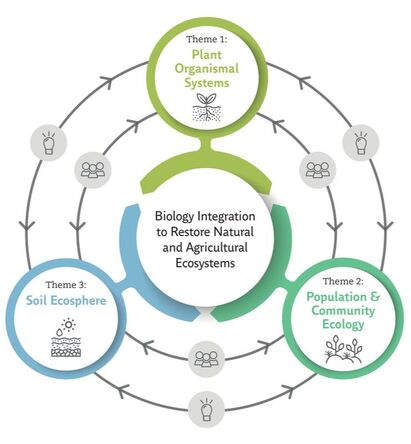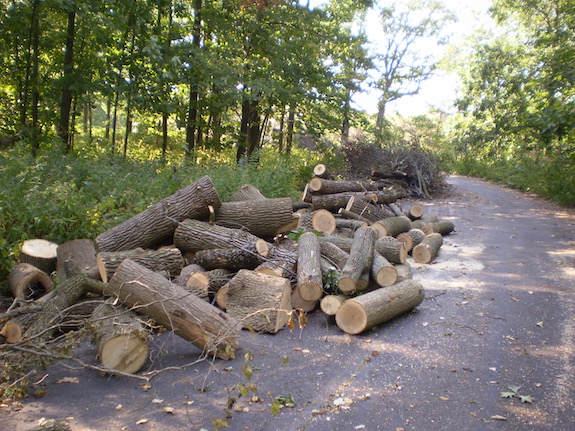 Restoration ecology research in the lab focuses on understanding how different restoration and management approaches influence outcomes. Work in my lab is primarily focused on addressing priority questions related to the restoration and management of diverse native plant communities in the Chicago region (check out this list of priority research needs identified by land managers around the region to get a sense of where the research needs are).
Restoration ecology research in the lab focuses on understanding how different restoration and management approaches influence outcomes. Work in my lab is primarily focused on addressing priority questions related to the restoration and management of diverse native plant communities in the Chicago region (check out this list of priority research needs identified by land managers around the region to get a sense of where the research needs are).
This includes addressing questions like:
How does trait variation within and between species impact restoration  outcomes? This work is part of the collaborative New Roots for Restoration Institute, which focuses on the overarching theme of how plant organismal systems (plant roots and shoots) relate to one another (1) and how those relationships influence and are influenced by plant communities (2) and the soil ecosphere (3). Coordinated projects and an Institute-wide training network bridge among disciplines to inform restoration of natural and agricultural ecosystems and to train the next generation of scientists. With Garden collaborators Kay Havens, Jacob Zeldin, Alicia Foxx, Louise-Egerton Warburton, and Nyree Zerega.
outcomes? This work is part of the collaborative New Roots for Restoration Institute, which focuses on the overarching theme of how plant organismal systems (plant roots and shoots) relate to one another (1) and how those relationships influence and are influenced by plant communities (2) and the soil ecosphere (3). Coordinated projects and an Institute-wide training network bridge among disciplines to inform restoration of natural and agricultural ecosystems and to train the next generation of scientists. With Garden collaborators Kay Havens, Jacob Zeldin, Alicia Foxx, Louise-Egerton Warburton, and Nyree Zerega.
Can we address key needs in plant conservation and restoration science, practice, and policy by bringing together diverse perspectives to enable analysis, synthesis, and  collaboration? This work is part of the new synthesis center for Conservation and Restoration, part of the Negaunee Institute for Plant Conservation and Action at Chicago Botanic Garden. One of our first projects involves understanding how rapid canopy loss (including that caused by Emerald Ash Borer) has impacted the understory vegetation of woodland plant communities around the Great Lakes Region.
collaboration? This work is part of the new synthesis center for Conservation and Restoration, part of the Negaunee Institute for Plant Conservation and Action at Chicago Botanic Garden. One of our first projects involves understanding how rapid canopy loss (including that caused by Emerald Ash Borer) has impacted the understory vegetation of woodland plant communities around the Great Lakes Region.
Why are restoration efforts involving conservative specie s like native violets rarely successful? This is the subject of a review paper in development as part of our synthesis center for Conservation and Restoration. Field and lab-based research also focuses on seed ecology and reintroduction of multiple native violet species, conducted with Kay Havens, former MS student Sam Kilgore, former postdoc Marcello De Vitis, and collaborator Linda MacKechnie at Ball Horticultural, as well as with land managers around the region.
s like native violets rarely successful? This is the subject of a review paper in development as part of our synthesis center for Conservation and Restoration. Field and lab-based research also focuses on seed ecology and reintroduction of multiple native violet species, conducted with Kay Havens, former MS student Sam Kilgore, former postdoc Marcello De Vitis, and collaborator Linda MacKechnie at Ball Horticultural, as well as with land managers around the region.
Is there a need to seed following the removal of invasive woody species? We are looking at the soil seed bank in upland woodland habitats (with MS student Nathan Lamb) as well as vernal pools (with former MS student Matt Evans) to understand whether passive restoration following buckthorn removal is likely to lead to desired plant communities. Nathan and Matt gave a webinar presentation to land managers in the Chicago Region shared the results of this research in February 2021 – see this link for a recording of their webinar and this link for a one page summary of their results.
Lab members and I have also worked on addressing restoration challenges in the western United States, including:
Colorado Plateau Restoration Outcomes Database (CPROD): To investigate how native plant materials used in a restoration perform over the short- and long-term, we assembled the Colorado Plateau Restoration Outcomes Database (CPROD), which assimilated seeding and monitoring data from multiple sources for habitat restoration projects occurring on the Colorado Plateau from 1994-2015. We included restoration projects that included a revegetation component occurring post-wildfire and/or post-disturbance, as well as after wildlife habitat improvement projects, prescribed burns, invasive plant treatments, soil stabilization projects, and transplanting projects were also included.
Our primary online data sources were the Utah Watershed Restoration Initiative (WRI) database for restoration activities occurring in Utah, and the USGS’s Land Treatment Digital Library database (LTDL), which contains information on restorations carried out by the Bureau of Land Management. In addition, we also obtained data through direct communication with the National Park Service and Bureau of Land Management. Project centroids, size, ecological site description, date of treatment/s, and the specific treatment/s associated with the project were entered into the CPROD database along with information about the commercial source, cultivar type, and price of each species seeded or planted for each of the revegetation treatments associated with the project, as available. We also recorded all available pre-treatment and post-treatment monitoring data associated with each project with the goal of determining which revegetated species and seed sources were considered “successful” (i.e. they showed up in post-treatment monitoring).
Components of this dataset are being used in different research projects, including investigating the role functional traits play in species establishment following seeding (Balazs, K. R., A. T. Kramer, S. M. Munson, N. Talkington, S. Still, and B. J. Butterfield. 2019. The right trait in the right place at the right time: Matching traits to environment improves restoration outcomes. Ecological Applications) and have been shared with the Global Arid Zone Project. Please contact Andrea Kramer if you are interested in using the dataset.